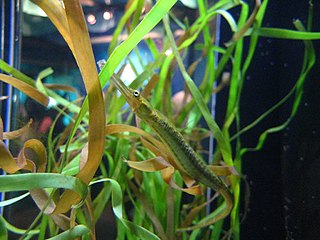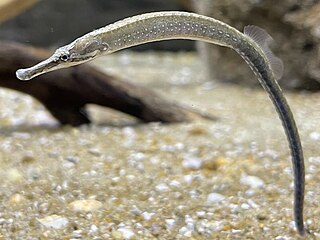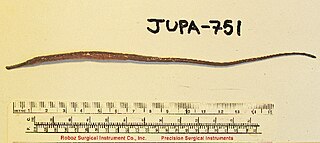
Syngnathus is a genus of fish in the family Syngnathidae found in marine, brackish and sometimes fresh waters of the Atlantic, Indian and Pacific Ocean. Fossils of these species are found from the Oligocene to the Pleistocene. They are known from various localities of Greece, Italy, Germany and United States.

The greater pipefish is a pipefish of the family Syngnathidae. It is a seawater fish and the type species of the genus Syngnathus.

The lesser pipefish or Nilsson's pipefish is a pipefish similar to the greater pipefish, but with no crest above the head. Usually it reaches up to 17 centimetres (6.7 in) in length, maximally 18 centimetres (7.1 in), although in South Wales they are usually not more than 10 to 13 centimetres long. They have a light to dark green-brown colour with bar-like markings on the sides.

The black-striped pipefish is a species of fish in the family Syngnathidae. It is found in the eastern Atlantic from the southern Gulf of Biscay to Gibraltar, also in the Mediterranean and Black Seas. As the introduced species it is mentioned in the Caspian Sea and fresh waters of its basin.

The estuarine pipefish or river pipefish is a species of fish in the family Syngnathidae. It is endemic to South Africa and has been sporadically recorded in the estuarine portions of the Kariega, Kasouga, Bushmans, East Kleinemonde and West Kleinemonde rivers. It can be readily distinguished from another southern African pipefish with which it shares its habitat, S. temminckii, by its much shorter snout. The estuarine pipefish is most commonly found in beds of the eelgrass Zostera capensis.

The bay pipefish is a pipefish native to the eelgrass beds of the Eastern Pacific, where its sinuous shape and green color allow it to blend in with the waving blades of eelgrass. Like other members of the seahorse family, male pipefish tend the eggs laid by their female partners in specialized pouches.

The broadnosed pipefish or deepnosed pipefish is a fish of the family Syngnathidae. It is native to the Eastern Atlantic from Vardø in Norway, Baltic Sea and the British Isles at north to Morocco at south. It is also found in the Mediterranean Sea, Black Sea and Sea of Azov. It is common in the coastal shallow waters, usually on reefs with seagrasses. This species is notable for its "broad" snout, which is as deep as its body.
Thickly snouted pipefish is a pipefish species which inhabits the Black Sea and Sea of Azov. It is a marine, demersal, ovoviviparous fish.
Syngnathus schmidti, the Black Sea pelagic pipefish or Schmidt's pipefish, is a pipefish species that inhabits the Black Sea and Sea of Azov. A freshwater/brackishwater fish, it can grow up to 11 centimetres (4.3 in) long and usually lives at a depth of 1 to 10 metres, although it can live as deep as 100 metres (330 ft). The specific name honours the Danish zoologist Ernst Johannes Schmidt (1877-1933).
Pelagic pipefish is a pipefish species of the family Syngnathidae.

The Pacific seaweed pipefish is a species of pipefish, found in the north-western Pacific Ocean, near Vladivostok (Russia), southern to Gulf of Tonkin. It is a marine, oceanic demersal fish, up to 30 centimetres (12 in) length. It is common in beds of Zostera sea grass.

The northern pipefish is a northwest Atlantic species of fish belonging to the family Syngnathidae.
The dusky pipefish is a species of the pipefishes, widespread in the western Atlantic from the Bermuda, Chesapeake Bay, northern part of the Gulf of Mexico, Bahama, and the western Caribbean Sea to Panama in south. Marine subtropical demersal fish, which lives at the depth up to 22 metres (72 ft), usually up to 4 metres (13 ft). The maximal length of the fish is 25 centimetres (9.8 in).
Syngnathus macrobrachium is a species of pipefishes, which is common in the southern-eastern Pacific in the coastal waters from Tumbes (Peru) to Puerto Montt (Chile). It is a marine subtropical demersal fish, up to 22.5 centimetres (8.9 in) length. Very little is known about this species' biology but it is thought that it lives over sand and other soft sea beds in shallow coastal waters including estuaries and brackish lagoons. This species is ovoviviparous, the males brood the fertilised eggs below the tail before giving birth to the larvae.

The southern pipefish is a pipefish species that inhabits the Southwest Atlantic near Uruguay. It is a marine subtropical demersal fish. This species has been recorded among beds of Ruppia maritima in the Lagoa dos Patos in southern Brazil, and apparently they spend the whole of their lives in sea grass beds. It is a carnivorous species which feeds mainly on copepods and isopods, although the females consume a wider variety of prey. It is an ovoviviparous fish, in which the males bear the fertilised eggs inside a brood pouch located beneath its tail. During the breeding season they are sexually dimorphic which indicates that the species is probably polygamous.
The chain pipefish is a pipefish species. It inhabits the western Atlantic from Virginia, Bermuda and northern Gulf of Mexico to Campeche and Jamaica, but is absent from the Bahamas. It is a marine subtropical reef-associated fish, up to 38 cm length.
The bull pipefish is a pipefish species of the western Atlantic, from southern Canada to Panama. It is a marine subtropical reef-associated fish, up to 38 centimetres (15 in) length.
Syngnathus macrophthalmus is a pipefish species, found only around Suez and Hurghada in the northwestern Red Sea. It is a marine tropical demersal fish, up to 12.2 centimetres (4.8 in) total length.

The kelp pipefish is a species of pipefish. It inhabits the eastern Pacific from the Bodega Bay in northern California, United States, to southern Baja California, Mexico. It is a marine subtropical demersal fish, up to 50 centimetres (20 in) length.
The Chocolate pipefish is a species of the pipefishes. Widespread in the Eastern Pacific from Redondo Beach in southern California, United States, to central Baja California, Mexico. Marine subtropical demersal fish, up to 25 cm length.











